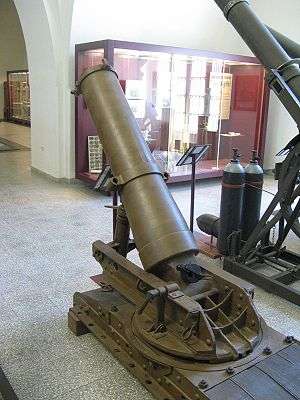26 cm Minenwerfer M 17
| 26 cm Minenwerfer M 17 | |
|---|---|
|
Böhler model at the Heeresgeschichtliches Museum, Vienna | |
| Type | Heavy trench mortar |
| Place of origin | Austria-Hungary |
| Service history | |
| In service | 1917-1924, 1938-1939[1] |
| Used by |
Austria-Hungary Austria Czechoslovakia Slovak Republic |
| Wars | World War I |
| Production history | |
| Designer | Skoda |
| Designed | 1917 |
| Manufacturer | Skoda, Böhler, Hungarian Gun Factory |
| Produced | 1917-18 |
| Number built | 300 |
| Specifications | |
| Weight | 1,550 kg (3,420 lb) |
| Crew | 6 |
|
| |
| Shell | 83 kg (183 lb) |
| Caliber | 260 mm (10 in) |
| Elevation | 34° to 80° |
| Traverse | 0° |
| Maximum firing range | 1,450 m (1,590 yd) |
The 26 cm Minenwerfer M 17 was a heavy trench mortar used by Austria-Hungary in World War I. It was developed by Skoda as an alternative to copying captured Italian 240 mm Trench Mortars. Skoda presented two versions, one with a rigid barrel, and the other with a recoil system. The former was chosen as it was simpler to produce. It was a muzzle-loading, rifled mortar that had to be levered around to aim at new targets. It disassembled into four pieces for transport.
First deliveries began in March 1918. Production averaged between thirty-six and forty a month for the rest of the war.
See also
| Wikimedia Commons has media related to 26cm Minenwerfer M 1917. |
References
- Ortner, M. Christian. The Austro-Hungarian Artillery From 1867 to 1918: Technology, Organization, and Tactics. Vienna, Verlag Militaria, 2007 ISBN 978-3-902526-13-7
External links
This article is issued from Wikipedia - version of the 12/3/2016. The text is available under the Creative Commons Attribution/Share Alike but additional terms may apply for the media files.
